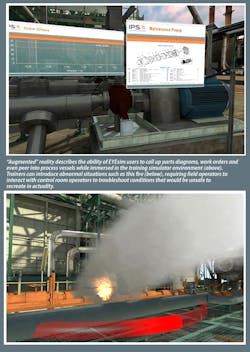Armed with 3D glasses and a joystick, Marizio Rovaglio deftly maneuvered through the virtual process plant, closing valves, conjuring work orders and putting out simulated fires. Despite the hotel conference room setting at this week's Invensys Client Conference, it was easy to be transported by this immersive, game-style simulator that for the first time marries first-principle simulation with "augmented" reality to enable engineers and operators to see and safely interact with the plant and the processes they control.
Called EYEsim, the system extends the scope of traditional simulator training to include not only the control room, but the field as well, explains Rovaglio, Invensys Operations Management group leader for innovation technologies and emerging services. Control room operators, as well as field operators and maintenance technicians, can now be trained in tandem, interactively solving problems over walkie-talkie under trainer supervision, he explained.
"The increasing complexity of plants, combined with a changing workforce, demands next-generation tools that can safely and interactively train new operators and engineers without putting them, the community or the environment at risk," added Tobias Scheele, vice president, advanced applications, Invensys Operations Management. "This system provides a stable, realistic environment for practicing routine operational and maintenance functions, as well as rarely performed volatile tasks such as plant shutdowns. In addition, using computer models of real equipment allows endless experimentation without ever taking the equipment off- line, mitigating risk to production as well."
Using and applying gaming and other skill sets most familiar to younger employees, the EYESim solution also appeals to employees new to the engineering and plant workplace, as well as experienced engineers. It combines virtual reality technologies with high-fidelity process and control simulation, computer-based maintenance and documentation management, and other applications to provide a highly realistic and safe training environment for improving operating efficiency and skills. Simulations are driven by the company's DYNSIM high-fidelity process simulator, FSIM Plus software, I/A Series control system emulation and other compatible programs.
By merging virtual plant imagery with screens from asset management or other application software, the Invensys solution creates a computer-generated representation of either a real or proposed process plant. Using a stereoscopic headset, trainees enter a completely immersive environment in which they can move throughout the plant. Such freedom is possible because the virtual environment is rendered at 60 frames per second, significantly faster than can be achieved by traditional, non-real-time rendering.
EYESim technology is geared toward the energy, chemical, oil and gas, and other vital process industries as they face knowledge management, training and retention challenges brought on by an aging and dwindling industry workforce.
"The loss of experienced workers and associated knowledge is increasing the risk of conducting safe, reliable and efficient plant operations, but the EYESim solution creates an environment in which operators and engineers can quickly absorb and use the wealth of process data and control system information that is available to them," said Tom Fiske, Ph.D. and senior analyst with ARC Advisory Group. "Traditional operator training simulators play a significant role in protecting knowledge assets, and these systems are evolving into increasingly more sophisticated simulators, such as the new solution from Invensys, which combines virtual reality and immersive technology with high-fidelity modeling to enhance knowledge protection and improve operator performance. Additionally, outside operators and other operational team members can use such simulators to provide more realistic and complete training experiences, or to assist in other asset management and operational activities."





